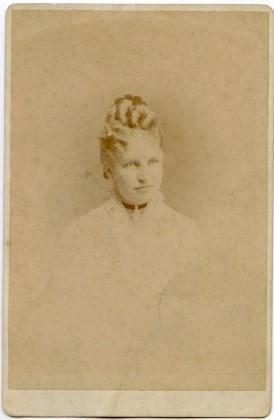
Edith Longfellow (later Dana) was born on October 22, 1853. Affectionately called “Boz,” by her sisters, the rest of the world knew her as “Edith with the golden-hair” from her father’s poem “The Children’s Hour.” As the middle daughter of Frances (Fanny) Elizabeth Appleton Longfellow and Henry Wadsworth Longfellow, she nonetheless demonstrated a strong personality with her mother writing that four-year-old Edith, “tho’ lovely as an angel, [wa]s rather obstinate & willful.”1 After Fanny’s death in 1861, Edith shared her childhood lessons with her sisters, Alice and Anne Allegra under Hannah Davie and following her year-long trip to Europe with family in 1868-9, she studied outside the home. In 1872, when Alice left to travel in Europe, Edith assumed Alice’s duties managing the household here at 105 Brattle. 
She and her father enjoyed a close relationship. They attended art and science lectures together before her marriage to Richard Henry Dana III, the son of their neighbor, the writer and abolitionist lawyer Richard Henry Dana Jr. Edith’s father mourned her absence from 105 Brattle – “Weddings leave vacant chairs as well as funerals; and she is lost to me.”2 She, however, returned to her 105 Brattle where she gave birth to Henry’s first grandchild in 1879. After her father’s death, she and Richard built their primary home next at 113 Brattle Street right next door to her childhood home, where her unmarried siblings still lived. Richard and Edith also built a summer home in Manchester on Dana Beach. She continued to be close with her sisters Alice and Anne Allegra, who remained her neighbors, and with her sister-in-law Elizabeth (“Lily”) Ellery Dana throughout her life. She, like them, participated in events honoring their father such as the 1914 dedication of Longfellow Park opposite 105 Brattle. 
Edith was a devoted mother in raising her six children: Richard Henry IV, Henry W.L. (“Harry”), Frances Appleton, Allston, Edmund Trowbridge (“Ned”), and Delia Farley. She also participated in civic activities, namely the Cambridge Historical Society, the Humane Society, and the Holy Ghost Hospital for Incurables. Inspired by her husband, she joined the Woman’s Auxiliary to the Civil Service Reform Society. Like much of her family, she was fascinated by history, particularly the history of her childhood home and its connection to George Washington. She marveled that here at 105 Brattle, “all day long I can walk the floors this greatest of men to us Americans trod.”3 Her husband and family searched in vain for a cure for the cancerous tumor that eventually killed her. She died July 21, 1915 at home in Manchester. ArticlesNotes
|
Last updated: October 17, 2024
